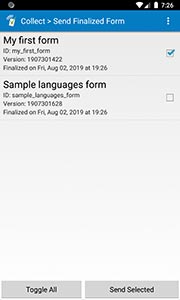Securely sending data via the Internet
Use the Send Finalized Form button on the main menu of SurveyCTO Collect to send finalized survey data to your SurveyCTO server. From your server console's Export tab, you can then export, publish, or even start analyzing that data. (If you are collecting sensitive data, be sure to read about encrypting your data.)
This, of course, requires that your device have an Internet connection – at least when you are transferring survey data from the device to the server (or retrieving blank forms from the server). Broadly, you have three options for Internet connectivity:
- 2g/3g/4g cellular network. If you put a sim card into each device and subscribe to an appropriate data plan, then each device will be able to upload data directly over a cellular network (when available).
- WiFi. Whenever your devices have access to a WiFi network (e.g., in your field office), they can use that network to upload data. Alternatively, you could transport only the SD (memory) cards to your field office, insert them into a WiFi-capable device, and upload data. That way, only the small SD cards – which contain all of the survey data – are transported to and from the field office. (This last option requires that your devices store their data on ejectable SD cards. See Finding and safeguarding local device data for more.)
- Tethered 2g/3g/4g cellular network. An alternative option is to have just one device per team that has a sim card and data plan (perhaps the supervisor's device). This device can enable tethering to share its cellular Internet as a "portable hotspot"; as long as they are nearby, other team members' devices can then use this portable hotspot to send their data. Thus, everybody on a team can share a single cellular data connection.
Since no Internet connection is necessary when collecting data, it is typical to disable all communications (i.e., go into "airplane mode") in order to conserve battery power. Communications can be re-enabled when you are ready to transmit data to the server.
Finally, for the most difficult or complex environments, you may be able to pull data directly off your devices, without going through the server. See Operating more fully offline (without the Internet) for details.

